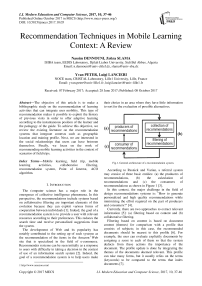Recommendation Techniques in Mobile Learning Context: A Review
Автор: Nassim DENNOUNI, Zohra SLAMA, Yvan PETER, Luigi LANCIERI
Журнал: International Journal of Modern Education and Computer Science (IJMECS) @ijmecs
Статья в выпуске: 10 vol.9, 2017 года.
Бесплатный доступ
The objective of this article is to make a bibliographic study on the recommendation of learning activities that can integrate user mobility. This type of recommendation makes it possible to exploit the history of previous visits in order to offer adaptive learning according to the instantaneous position of the learner and the pedagogy of the guide. To achieve this objective, we review the existing literature on the recommendation systems that integrate contexts such as geographic location and training profile. Next, we are interested in the social relationships that users can have between themselves. Finally, we focus on the work of recommending mobile learning activities in the context of scenarios of field trips.
Mobile learning, field trip, mobile learning activities, collaborative filtering, recommendation system, Point of Interest, ACO algorithm
Короткий адрес: https://sciup.org/15015009
IDR: 15015009
Текст научной статьи Recommendation Techniques in Mobile Learning Context: A Review
Published Online October 2017 in MECS DOI: 10.5815/ijmecs.2017.10.05
The c omputer science has a major role in the emergence of collective intelligence phenomena. In this perspective, the recommendations include systems based on collaborative filtering are important elements of this evolution because they can exploit various forms of cooperation between individuals [1]. Indeed, the goal of a recommendation system is to provide a user with relevant resources according to their preferences. This reduces the search time and receive personalized suggestions from the system.
The development of Web and its popularity has notably contributed to the setting up of such systems as the recommendation of the items in the Amazon1 Web site that is specialized in the field of e-commerce. Recommender systems can be seen initially as a response to users with difficulty in taking a decision in the context of use of an information search system [2]. Indeed, the goal of a recommendation system is to help users make their choice in an area where they have little information to sort for the evaluation of possible alternatives.
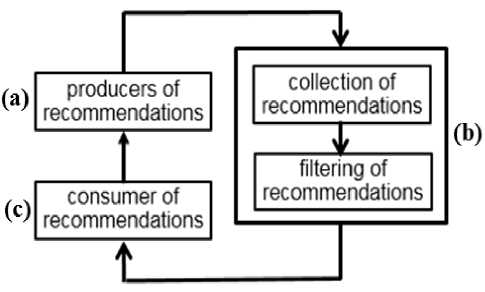
Fig.1. General architecture of a recommendation system.
According to Resnick and Varian, a referral system may consist of three basic entities: (a) the producers of recommendations, (b) the calculation of recommendations and (c) the consumers of recommendations as shown in Figure 1 [3].
In this context, the major challenge in the field of design recommendations systems is: "How to generate personalized and high quality recommendations while minimizing the effort required on the part of producers and consumers?" [4].
Currently, there are two approaches to extract relevant information [5]: (a) filtering based on content and (b) collaborative filtering.
Filtering based on content is based on document content (themes) for comparison with a profile that consists of subjects; in this case, the recommended documents should be nearest to this profile [6]. For example, the user can evaluate explicitly documents by assigning a score to each of them so that the system deducts from these actions the importance of the document. The profile update is done by integrating the themes of the documents deemed relevant. This profile can take many forms, but it usually relies on the terms (keywords) to be compared to the terms that index documents [7].
However, filtering based on content suffers from some problem such as: (1) the difficulty of indexing the multimedia documents related to the identification of relevant content or (2) the funnel effect where the user profile is evolving by progressive restriction on the searched subjects [6] [7].
The motivation of collaborative filtering is to extend the concept of sharing between friends to thousands of people on the Internet: friends (some people) can recommend what they liked; Internet thousands of people are likely to give you their opinion. The objects for which you want to evaluate the interest of Internet users can be of any kind: movies, music, restaurants, games, jokes, articles, etc. [8] [9] [10].
According to Bechet, we can distinguish two types of collaborative filtering: (1) the active collaborative filtering based on evaluations (notes, reviews) provided explicitly by users and (2) passive collaborative filtering based on an analysis of user behavior made in the background. We thus establish a constructive relationship between the activity of the user and preferences [11].
In this context, we are particularly interested in the recommendation of learning activities to places that others have already visited and evaluated explicitly or implicitly. Indeed, the collaborative filtering takes into account the proximity between learners, this proximity reflects the similarity of interests in order to emerge the concept of group or community [12]. For example, if two students A and B have evaluated a number of educational activities similarly there are chances that learners A and B share the same interests in the learning scenario [7].
In this article, we will make a state of the art on different recommendation techniques of learning activities focusing on their strengths and weaknesses in the context of the design and implementation of mobile learning scenarios. In section 2 of this article, we make an overview on using recommendation systems where users are mobile. Then, in section 3 we focus on the recommendation of training content according to previous actions of learners. In section 4 of this article, we explain how social networks can be used in the recommendation process of learning activities.
Finally, in the last section, we present the various recommendation systems that can be used in the domain of field trips.
-
II. Recommendation Systems and Mobility
In the context of mobility, the user's geographical location is the first filter that will be added to the traditional filter of the user's profile. The first location services were developed in car navigation systems that are widely available. The driver can receive an advice guide throughout its path with visual or audio messages indicating the route to follow. These councils use the knowledge of the previously calculated route and the current position of the vehicle. More recently, "Locationbased Services" or LBS, using the position of mobile obtained by triangulation allow considering the same type of services for pedestrians [13].
In this context, applications are many and varied, we can mention tourism for example [15] [14] where the recommendation is used in the field of restoration. This type of application can help tourists during their visits to the region during one or more days. However, sometimes it is not possible to visit all the tourist attractions and historical sites during a limited period. The tourist must make a selection of Points Of Interest (POI) to visit.
Niaraki and Kim have developed a method to customize the route planning. They evaluate several criteria, which are defined in an ontology describing the road segments to follow. The user declares the number of POIs to visit and the shortest path algorithms such as Dijkstra’s2 algorithm can be used to calculate personal routes from the starting point to the end based on these declarations [16].
Yu and Zhang have developed a framework for a personalized recommendation of hotels, restaurants and POIs. They combined these three functionality in a touring recommendation process that recommends a personalized visit based on the current time and location of the user and its interests [17].
City trip planner 2 allows making city tours adapted to the context of the user and his personal interests. This system includes visits over several days for each POI by offering multiple time slots that can change daily. In addition, lunch breaks can be programmed and the local tourist office can suggest a few POIs to include in the initial trip. On the other hand, City trip planner 2 includes path selection and routing between these POIs [18].
Another more recent example of this type of application named "Aurigo" also allows planning routes for a personalized visit. This application is based on a recommendation algorithm and a display interface using an interactive map [19].
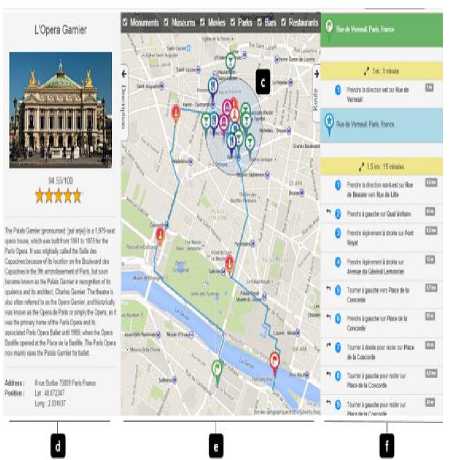
Fig.2. The exploration page of Aurigo describes a touring composed of (a) the total distance, (b) the filter bar, (c) the radius, (d) the description panel, (e) the card and (f) the road.
These works are part of LBS because they use the recommendation in the context of mobility. In addition, they include a number of areas such as m-commerce or m-tourism exploiting a location service and the profiles declared by users.
In this section, we analyzed works on m-tourism and m-commerce that use the location of the point of interest in their scenarios of field trip. These works integrate some specific functionality of LBS. For example, they can recommend POI according to the planning of the visit and the enrichment of POIs by tourist office. However, this type of recommendation does not include all the elements necessary to the orientation of learning with an educational objective.
-
III. Recommendation Systems and Training
Recommendation systems can generate suggestions on new items or predict the usefulness of an item for a given user. In the domain of intelligent tutoring (EIAH in French), these systems allow to estimate the interest of a user for a given resource or learning activity from certain information about other similar users.
According to Drachsler, the recommendation of learning content from a potentially very broad set of choices can be done using the experiences of a community of learners [20]. Indeed, in the literature, many learning systems can offer individual recommendations to learners. These systems rely on technologies such as metadata and ontologies to define relationships, conditions, and dependencies between learning resources and learners' models [21]. These systems are mainly used in closed-corpus applications where learning resources can be described by the scenario designer. This description integrate semantic relationships to provide formal learning for learners. [22].
In institutional educational settings such as universities, the learning scenario is well structured through formal relationships (metadata) that integrate accreditation procedures and learner profiles [23]. These metadata can be used to recommend courses through the adaptation of the resources to be consulted and the activities to be realized in relation to the different profiles of the learners.
In this context, Educational Hypermedia Systems (EHS) can be used to personalize learning based on (1) the learner model described from its interests and (2) a mechanism for adapting the hypermedia according to the state of the user's model [24].
However, in these systems, many design activities are required before execution and during maintenance of the learning environment. In addition, knowledge domains in the learning environment must be described in detail. For this reason, these adaptive hypermedia techniques are less applied in the context of the recommendation of learning activities [21].To solve this design problem, informal learning networks offer an interesting solution because they can help build a first representation of the domain of knowledge. This type of network is populated by many learners and offers activities planned by the "facilitators" of learning. Under the learning scenario, each learner is allowed to add, modify, delete or evaluate learning resources at any time [25]. Then, data extraction techniques must be able to create a representation of the user or domain model. However, this representation is sometimes significant because it is based on information provided by the learners without any standardization (no profile information).
On the other hand, according to Brusilovsky and Henze, the absence of maintenance of the structure in informal learning is called the "open corpus problem". This problem arises when learning resources provided by learners can not be indexed with domain concepts or community metadata [26].
As a result, recommendation techniques such as collaborative filtering are more appropriate because they require little maintenance and improve the community's emerging behavior. Drachsler et al. Analyzed how different types of collaborative filtering techniques can be used to assist learners in informal learning networks [27].
Finally, we can consider that the recommendation systems provide contextual help that helps guide learners during the course of their learning. For this reason, several learning recommendation systems have exploited collaborative filtering techniques during the last decade. We cite as examples of projects: Altered Vista (2003), RACOFI (2003) and QSIA (2004).
Altered Vista is an educational system that supports a form of contextual collaborative learning. Its design integrates a form of collaborative filtering that uses the work of individuals for the benefit of a group of users. Altered Vista is designed to provide, upon request, recommendations from custom websites or contacts. This makes it possible to spread word-of-mouth opinions in educational settings in order to recommend a network of potentially interesting people [27].
The RACOFI Musique project allows learners to become familiar with contemporary Canadian music. This system helps online users in the classification and recommendation of audio objects. It allows users to evaluate contemporary Canadian music in five dimensions: (1) printing, (2) lyrics, (3) music, (4) originality, and (5) production. Collaborative filtering algorithms are then used to recommend musical objects close to the interest expressed by users' requests in order to guarantee a good understanding of the characteristics of contemporary Canadian music [29].
The QSIA (Questions Sharing and Interactive Assignment) project is a distributed web-based system that describes an environment for learning, assessment and knowledge sharing. Indeed, this project allows collaborations through online recommendations and generates new communities of teachers and learners. At the same time, the QSIA project promotes individual learning and could promote the capitalization of learners' collective intelligence [30].
In this section, we explained that recommendation systems use hyperlinks to provide resources to learners. However, some resources may not be available as part of a field trip scenario.
For example, to access the description of a given place, the learner must mark on the map the link or the POI associated with it.
-
IV. Recommendation Systems and Social Networks
Recommendation techniques that use data from social networks are named SNBLs (Social Network-Based Recommendation). The majority of these techniques are based on traditional approaches to filtering content or collaborative filtering with improvements and extensions that enable easy integration of social data [31]. In the following, we present the three main approaches associated with this type of recommendation.
-
A. Recommendation based on trust
In recent years, the growth of social networks has enabled the development of techniques based on trust (trust-based recommendation). For example, we can cite "FilmTrust" or "TrustedOpion" that recommends restaurants, cafes, bars and movies through a website. These social recommendation forms are organized into two main steps: (1) the construction of a model of confidence and (2) use of a computational model to estimate the level of interest of an object to an individual [32] [33].
In literature, the notion of "trust" can be defined through the friendship described using the social graph. Indeed, in a social network, the common elements between two individuals (belonging to the same community, the objects they like ...) can be used to calculate a confidence value. Recommender systems are adopting this definition to do a conventional collaborative filtering based on the relationship of similarity between individuals [32] [33].
On the other hand, O'Donovan and Smyth incorporate the notion of "reputation" in the implementation of recommendation systems. This concept is indicative of the overall confidence gained by a user based on his past behavior. However, to improve the quality of recommendations, the notion of "trust" is introduced at the object (item-level trust) to exploit precisely the knowledge of each individual on a domain or a class of objects to recommend [34].
-
B. Exploitation of Textual Data in the Social Web
Among the textual data generated by the users in the social Web, the tags are the most used for the recommendation. A tag is a term associated with information such as an image, an article, or a video clip.
The creator or consumer of the object usually chooses tags personally. Many social networks allow users to add tags to objects for a later retrieval. For example, we cite a work that has shown that tags are good representations of users' interests and that they can be used to spot their preferences [31].
The notion of folksonomy is considered a classification system of tags representing a view of the user on all the contents of a system [35].
In this context, the authors present a method for the automatic consolidation of the profiles of the users, according to their tags through several folksonomies. This method allows the construction of a semantic profile of interest through four steps: (1) identification of the accounts held by a particular individual on different social networks (2) harvesting the complete history of tags relating to that individual within (3) filtering tags by eliminating spelling errors, synonyms, etc. and (4) semantic generation of user profiles from filtered tags [31].
Carmagnola et al. have used a knowledge-based model where the user's interest profile is represented by an ontology. The objective of this model is to use "social" annotations (comments and tags) as a means to deduce knowledge about users [33].
On the other hand, some recommendation systems use tags without considering the semantic aspect. In this case, only the tags on the recommended objects are used. The method proposed by Liu is based on the graph named user-object-tag (Figure 3) to calculate the level of interest of a user for an object from this graph [36].

Fig.3. The graph user-item-tag [36]
The recommendation system of Bank and Franke uses consumer evaluations to discover the level of satisfaction of a consumer on a characteristic of the product. This analysis is carried out in three stages: (1) pre-processing based on a syntactic and linguistic analysis (2) detection of the aspect of the product to be evaluated and (3) an analysis of the feeling to obtain the level of satisfaction of the consumer [37].
The studies presented above show the possibility of using textual data to enrich the preferences profile. These studies do not encounter the problem of cold start but are limited by their complexities (textual analysis, linguistics, knowledge model, ontologies ...).
-
C. Exploitation of declarative profile
Most Web sites allow users during their registration, to report a profile, which is made up of demographics and interests. This information can be used to populate the user preference profile in a recommendation system. However, there are no existing recommendation systems that rely solely on demographics.
A system can hardly give relevant recommendations because there is not a significant correlation between the taste of an individual and demographic information. Nevertheless, we can use this data as an additional source to improve the performance of the system [38] [39].
For example, we can mention the project presented in [40]. In this one, the authors propose a collaborative filtering demographic information to recommend music from ratings (ratings) assigned to each song.
On the other hand, this type of recommendation is sketchy due to declarative user profiles, but it presents a good solution for the cold start problem because the demographics are still available and can be collected easily.
The works presented in this section shows that the exponential growth of the social web presents exciting opportunities but poses real challenges to improve the quality of recommendations.
In addition, social network users are no longer just consumers of information but also producers of large data volumes that can be: (1) explicit introduced by the declaration of profile users, or (2) implicit deduced from interactions between participants.
In this context, the recommendation techniques previously presented use these two types of data sources to develop new strategies to reduce information overload. These strategies sort and filter information to recommend friends, places and services thanks to the social relationships. However, social networks can also be difficult because the nature of interaction between people is sometimes complicated to analyze.
-
V. Recommendations System and Field Trips
Many systems based on automatic recommendation of POIs can facilitate learning during field trips. These systems are based on algorithms that make the orchestration of mobile activities to provide a learning path adapted to the geographical context of each learner. In the following, we will classify the different recommendation techniques of POIs into three categories: (1) collaborative filtering techniques, (2) social recommendation techniques and (3) chronologic techniques.
-
A. Collaborative filtering techniques
According to Candillier, methods by collaborative filtering usually give better results than the content filtering [41]. Their uses to recommend POIs within this mobile learning scenario can be classified into two categories:
A.1. Implicit collaborative filtering techniques:
This kind of POIs recommendation technique is based on intelligent models swarm, especially the ant colony optimization algorithms [42] or ACO (Ant Colony Optimization) to guide learners during the course of their field trips [43]. These techniques can recommend learning paths adapted to the context of each learner. To achieve this objective, the structure of the learning scenario is described as a graph where the lessons are nodes and edges represent HTML links between them as shown in the figure 4.
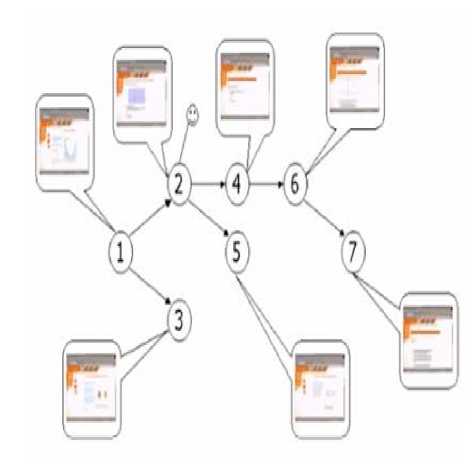
Fig.4. Description of the learning scenario as a graph or each node is a lesson and each arc is an HTML link [44].
These recommendation systems as well allow the orchestration of learning activities according to the value of the educational importance of an arc relative to other neighboring arcs. This value varies depending on the use of these links by learners who are represented by virtual agents (ants).
According Valigiani, the ant colony algorithm can be applied in a learning environment described using a graph of links between POIs. The structure of this graph can be optimized to facilitate the learning process through the participation of learners during the course of the field trip [44].
T. Wang proposes a different approach based on the ACO algorithm to help learners to to progress in their individualized learning using an adaptive learning path. This type of recommendation identifies POIs that are most likely to be chosen to form an optimal path based on different learning styles [45].
E. Kurilova presents a new approach to recommend learning paths adapted to different groups of learners. The ACO algorithm is used for the selection and combination of sequences of POIs according to learner preferences. This recommendation allows rearrange the POIs using the marking of learners in order to individualize and optimize the learning path [46].
These three works may be used in a mobile learning scenario because they can guide the path of learners globally. However, these studies take little interest in managing the context of the learner as they are based on the principle of implicit collaborative filtering of POIs that neglects the profile declared by the learners. Therefore, the orientation of the learning process can be done according to the most dominant profile, which handicap the specific context consideration of each learner.
A.2. Explicit collaborative filtering techniques:
In [47], the authors present a technique that allows an explicit collaborative filtering to better personalize the recommendation of POIs. This method is essentially based on all assessments made by the owner of the mobile device as well as the ratings of other users.
According to W-V. Zheng, the analysis of the history of GPS traces on ancient visitors, also allows to make a recommendation on some POIs activities [48]. Indeed, this analysis reinforces certain paths compared to others because it relies mainly on the rate of attendance of a course during the visit as shown in figure 5.
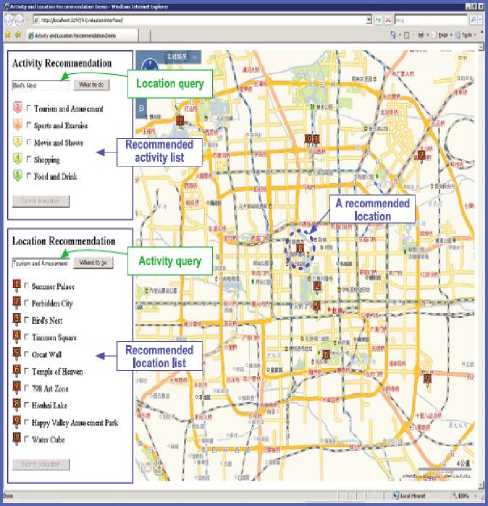
Fig. 5. Interface relative to the recommendation of the POIs according to the history of the GPS trajectories [48].
On the other hand, Phitchaya-Anutarat offers technical recommendation to assist the user to select the appropriate POIs according to their preferences and interests. This approach uses demographic techniques as the score of personal interest and profile of users available in the system database [49].
These three works are based on explicit collaborative filtering based on historical available after several visits to provide personalized recommendations. For this reason, the little collection system relevant information from traces of visited sites and user profiles. However, this kind of system suffer from the cold start problem for the first recommendations to be made. Ultimately, such a recommendation does not seem adapted to the learning objectives because it uses the history of the visit without worrying about the educational dimension of mobile learning scenario.
-
B. Social recommendation techniques
In the context of mobile learning scenarios, Ye has developed an algorithm based on the Naive Bayes classifier to recommend POIs based on user preferences, location and social influence. This algorithm uses the LBSN (Location-Based Social Networks) allowing users to establish trust between friends or other users to share tips and experiences of their visits. This recommendation service aims to recommend POIs to new visitors to help them to explore new places to better know a city (restaurant, cinema, theater, museum ...) as shown in figure 6 [50].
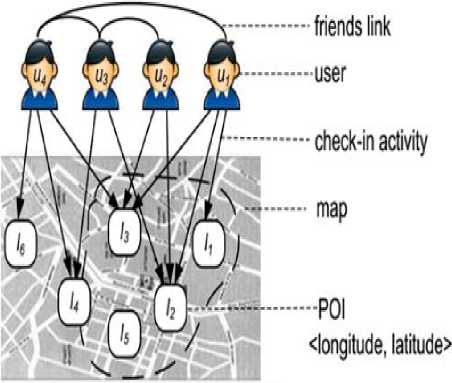
Fig.6. Graphical representation of the influence of friendship between users and their locations for the choice of activities in a LBSN [50].
On the other hand, "Biancalana" describes a recommendation system based on social relations that can identify user preferences and information needs. These parameters can be used in an information filtering process to suggest a personal recommendation from a number of POIs related to the current location of the user [51].The proposed approach allows the use of LBSN to identify user preferences by filtering information. It also allows to exploit the increasing quantity of information from social networks through user reviews to allow a recommendation of quality of POIs.
There are several works on LBSN, however we cite, as an example this two works because they can recommend POIs through social relationships that can exist between learners. However, the scenario of field trip starts without historical because it has no social interactions of learners. For this reason, this kind of recommendation seems unsuited to start a first visit because it will not provide POIs that are close to the spatio-temporal context of the learner.
-
C. Chronologic recommendation techniques
To ensure a personalized recommendation of POIs, various research has been done in the literature (LBSNs, ACO ...). However, these studies neglect the temporal relationship in the recommendation of POIs, for example if a user wants to participate in the scenario of the field trip tomorrow or in the coming days. In this context, the work of Sang [52] recommend a series of activities associated with a set of relevant POIs relative to user location and time of the visit taking into account the history of activities already performed. This approach allows users to schedule consecutive activities based on the probability of transition from one POI to another and the history in a Markov chain. Although the existing research focuses mainly on the recommendation of one step (the next activity to do in the current context) this work goes further by recommending a series of sequential activities [52].
On the other hand, the Work of Cheng aims to explore user preferences, social influence (the relationship between friends) and geographical influence (spatial grouping) to make POIs recommendations using a collaborative filtering. This approach propose a personalization of the Markov chain to predict the visit of POIs from a historical relating to a geographical area [53].
This system is powered by the behavior of users who share their locations, their advice and experiences as shown in Figure 7
These two works can be used to allow a prediction of the POIs to visit. However, this type of recommendation relies only on the historic of learners and neglects the teacher's point of view.
In the following, we classify in Table 1 the techniques of recommendation presented in this section
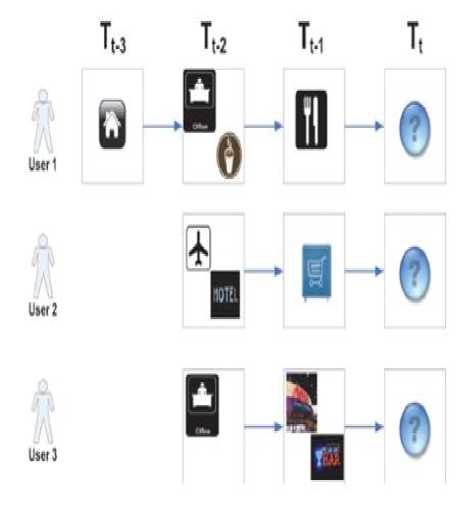
Fig.7. Graphical representation of the influence of friendship between users and their locations [53].
Table 1. Comparison between the different recommendation approaches in the context of field trip
|
Existing works |
|||||
|
[44] [45] [46] |
[47] [48] [49] |
[50] [51] |
[52]. [53]. |
||
|
и |
Supporting the spatial-temporal context |
Yes |
Yes |
Yes |
Yes |
|
Interaction between participants |
Clicks on hyperlinks |
GPS Tracks and Ratings |
Social relations |
GPS Tracks and Ratings |
|
|
Scenario enrichment |
Learner |
Learner |
Learner |
Learner |
|
|
Real-time collaboration |
Implicit collaborative filtering |
Explicit collaborative filtering |
Social Collaborative Filtering |
Calculating the probabilities of predicting POIs |
|
|
Integration of the 3 phases of the field trip |
Only in the visit phase |
Only in the visit phase |
Only in the visit phase |
Only in the visit phase |
|
|
Supporting unexpected situations |
Yes |
Yes |
Yes |
Yes |
|
-
VI. Conclusion
This state of the art allows providing an overview of the work related to the places recommendation in the context of field trips. These techniques are based on collaborative filtering POIs to guide learners according to their preferences expressed during the visit. They can also use social or temporal relationships resulting from the interactions between learners to predict sequences of learning activities to realize.
Furthermore, the real-time collaboration between tour participants through mechanisms such as collaborative filtering (explicit, implied, social, chronologic...) can help recommender systems to offer POIs corresponding to a personalized learning environment.
In this context, POI suggestions could come from different sources: instructors, communities of experts and learners. In addition, the selection of participants to the visit largely depends on their individual preferences. In this way, learners become more independent and responsible for their own learning pace. However, the POI recommendation must take into account all interactions between learners as well as the teacher's perspective.
For this reason, field trip scenarios must be based on the teacher's work during the pre- and post-visit phase so thatlearners do not move away from the formal objectives of the field trip.
In addition, participants in the learning scenario can create, share resources and implement learning activities to discover the new environment (Zoo, campus, city ...), and this generates a large amount of POIs [ 54] [55].
In this perspective, we believe that creating of a new approach for mobile learning scenario models is necessary to integrate the educational constraints and learners spatiotemporal profiles [56] [57].
Acknowledgment
The authors wish to thank all members of NOCE Team. This work was supported in part by CRISTAL laboratory.
Список литературы Recommendation Techniques in Mobile Learning Context: A Review
- q
- L. Lancieri, “Collective intelligence in a computer-mediated environment”, Chapter 8 in Handbook of Research on Democratic Strategies and Citizen-Centered E-Government Services, DOI: 10.4018/978-1-4666-7266-6, ISBN13: 9781466672666; IGI Global Editor, 2015.
- N. Béchet, « État de l’art sur les Systèmes de Recommandation », Projet AxIS de l’INRIA, dans le cadre du projet Addictrip, 2012.
- P. Resnick & H. Varian, “Recommender systems”, Communications of the ACM, 40(3), pp 56–58, 1997.
- S. Chelcea, G. Gallais & B. Trousse, « Recommandations personnalisées pour la recherche d’information facilitant les déplacements », Mobilité & Ubiquité, June 1-3, 2004, Nice, France, ACM 1-58113-915-2/04/0006, 2004.
- Y. Wei, Z. Jennings, R. Moreau and N. Hall, “User evaluation of a market-based recommender system. Journal of Autonomous Agents and Multi-Agent Systems”, pp 251-269, 2008.
- Z. Zaier, « Modèle multi-agent pour le filtrage collaboratif de l’information », Thèse de doctorat de l’université du Québec à Montréal, 2010.
- I. Boussebough, « Les système multi-agent adaptables », Thèse de doctorat en sciences, Université Mentouri Constantine, 2011.
- P. Bedi, R. Sharma & H. Kau, “Recommender system based on collaborative behavior of ants”, Journal of Artificial Intelligence. ISSN 1994-5450, pp 40-50, 2009.
- W. Gao, S. Wang and N. Cerrone, “A dynamic recommendation system based on log mining”, International journal of foundations of computer science. Vol. 13, N° 4, pp 521-530, 2002.
- L. Lancieri, M. Manguin & S. Mangon, “Evaluation of a recommendation system for musical contents”, IEEE International Conference on Multimedia & Expo, Hannover, (ICME), 2008.
- N. Béchet & M. Aufaure « Construction et peuplement de structures hiérarchiques de concepts dans le domaine du e-tourisme » IC’2011(Ingénierie des connaissances).
- M. Lopez, « Accès à l’information par un système de filtrage collaboratif contrôlé », Thèse de doctorat à l’Université Grenoble I, 2005.
- S. Chelcea, G. Gallais & B. Trousse, « Recommandations personnalisées pour la recherche d’information facilitant les déplacements », Mobilité & Ubiquité, June 1-3, 2004, Nice, France, ACM 1-58113-915-2/04/0006, 2004.
- Y. Wang, N. Stash, L. Aroyo, L. Hollink &G. Schreiber, “Using semantic relations for content-based recommender systems in cultural heritage”. In Proceedings of the Workshop on Ontology Patterns (WOP) at ISWC, 16–28, 2009.
- M. Hosseini-Pozveh, M. Nematbakhsh & N. Movahhedinia, “A multidimensional approach for context-aware recommendation in mobile commerce”, International Journal of Computer Science and Information Security, 2009.
- A. Niaraki & K. Kim, “Ontology based personalized route planning system using a multi-criteria decision making approach”, Expert Systems with Applications, pp 2250–2259, 2009.
- C. Yu & H. Chang, “Personalized Location-Based Recommendation Services for Tour Planning in Mobile Tourism Applications”. In: Di Noia, T., Buccafurri, F. (eds.) E-Commerce and Web Technologies. LNCS, vol. 5692, Springer, Heidelberg, pp 38–49, 2009.
- P. Vansteenwegen, W. Souffriau, G. Vanden Berghe & D. Van Oudheusden, “The city trip planner: an expert system for tourists”, Expert Systems with Applications 2010.
- A. Yahi, A. Chassang, L.Raynaud, H. Duthil, D. Horng & C. Aurigo, “An Interactive Tour Planner for Personalized Itineraries”, ACM 978-1-4503-3306-1/15/03, 2015.
- H. Drachsler, “Recommender systems for learning”, http://fr.slideshare.net/Drachsler/recsystel-lecture-at-advanced-siks-course-nl, 2014.
- N. Manouselis, H. Drachsler, K. Verbert, & E. Duval, “Recommender Systems for Learning” – An introduction – Handbook, Springer, 2012.
- P. Brusilovsky & N. Henze, “Open Corpus Adaptive Educational Hypermedia”, Brusilovsky P, Kobsa A, Nejdl W (eds), The Adaptive Web: Methods and Strategies of Web Personalization, LNCS 4321, Berlin Heidelberg NewYork: Springer, pp 671-696, 2007.
- M. Kocaleva, I. Stojanovic & Z. Zoran, “Model of e-Learning Acceptance and Use for Teaching Staff in Higher Education Institutions”, International Journal of Modern Education and Computer Science (IJMECS), vol. 7, N 3, pp 23-34, 2015.
- P. Brusilovsky & W. Nejdl, “Adaptive Hypermedia and Adaptive Web. Practical”, Handbook of Internet Computing, CRC Press LLC, 2004.
- R. Koper, E. Rusman & P. Sloep, “Effective Learning Networks”, Lifelong Learning in Europe, pp18-27, 2005.
- P. Brusilovsky & N. Henze, “Open Corpus Adaptive Educational Hypermedia”, Brusilovsky P, Kobsa A, Nejdl W (eds), The Adaptive Web: Methods and Strategies of Web Personalization, LNCS 4321, Berlin Heidelberg NewYork: Springer, 671-696, 2007.
- H. Drachsler, H. Hummel & R. Koper, “Personal recommender systems for learners in lifelong learning: requirements, techniques and model”, International Journal of Learning Technology, 3(4), pp 404-423, 2008.
- M. Recker & A. Walker, “Supporting “word of mouth” social networks through collaborative information filtering”, Journal of Interactive Learning Research, 14(1), pp 79-98, 2003.
- M. Anderson, M. Ball, H. Boley, S. Greene, N. Howse, D. Lemire & S. McGrath, “RACOFI: A Rule-Applying Collaborative Filtering System”, 2003.
- R. Sheizaf, B. Miri, D.-G. Yuval & T. Eran, “QSIA – a Web-based environment for learning, assessing and knowledge sharing in communities”, Computers & Education 43, pp 273–289, 2004.
- D. K. Le Tran, « Conception et développement de fonctionnalités innovantes liées à Facebook pour un système de recommandation ». Rapport bibliographique Dept. Logique des Usages, Sciences Sociales et de l'Information Telecom Bretange, 2011.
- Naziha Abderrahim & Sidi Mohamed Benslimane, “Towards Improving Recommender System: A Social Trust-Aware Approach”, International Journal of Modern Education and Computer Science (IJMECS), vol. 3, N 4, pp 8-15, 2015.
- F. Carmagnola, F. Vernero, & P. Grillo, “Sonars : A social networksbased algorithm for social recommender systems”, volume 5535 de Lecture Notes in Computer Science, Springer Berlin/ Heidelberg, 10.1007/978-3-642-02247-0-22, pp 223-234,2009. Zancanaro, editeurs: User Modeling, Adaptation, and Persona-lization, volume 5535 de Lecture Notes in Computer Science, Springer Berlin/ Heidelberg, 10.1007/978-3-642-02247-0-22, pp 223-234, 2009.
- J. O'Donovan & B. Smyth, “Trust in recommender systems”, Proceedings of the 10th international conference on intelligent user interfaces, IUI '05, New York, NY, USA, ACM, pp167-174, 2005.
- M. Szomszor, H. Alani, I.Cantador, K. O'Hara & N. Shadbolt, “Semantic modelling of user interests based on cross-folksonomy analysis”, 7th International Semantic Web Conference (ISWC), 2008.
- Z.-K. Z. Liu, Y.-C. Zhang & T. Zhou, “Solving the cold-start problem inrecommender systems with social tags”, 2010.
- M. Bank & J. Franke, “Social networks as data source for recommendation systems”, Will Aalst, John Mylopoulos, Norman M. Sadeh, Michael J. Shaw, Clemens Szyperski, Francesco Buccafurri et Giovanni Semeraro, editeurs : E-Commerce and Web Technologies, volume 61 de Lecture Notes in Business Information Processing, Springer , 49-60, 2010.
- M. J. Pazzani, “A framework for collaborative, content-based and demographic filtering”. Artif. Intell. Rev., 13, pp 393-408, 1999.
- M. Vozalis & K. G. Margaritis, “On the enhancement of collaborative filtering by demographic data”. Web Intelli. and Agent Sys., 4, pp117-138, 2006.
- B. Yapriady & A. L. Uitdenbogerd, “Combining demographic data with collaborative ltering for automatic music recommendation”. In Rajiv Khosla, Robert J. Howlett et Lakhmi C. Jain, editeurs : Knowledge-Based Intelligent Information and Engineering Systems, volume 3684 de Lecture Notes in Computer Science, Springer Berlin /Heidelberg, 2005. 10.1007/11554028-29., pp 201-207, 2005.
- L. Candillier, K. Jack, F. Fessant, & F. Meyer, “State-of-the-art recommender systems”, Collaborative and Social Information Retrieval and Access, 2009.
- M. Dorigo, V. Maniezzo & A. Colorni, “Ant system: optimization by a colony of cooperating agents”, IEEE Transactions on Systems, Man, and Cybernetics--Part B, volume 26, numéro 1, pp 29-41, 1996.
- R. Sangita & C. Sheli Sinha, “Bio-inspired Ant Algorithms: A review”, International Journal of Modern Education and Computer Science (IJMECS), vol. 4, N 4, pp 25-35, 2013.
- G. Valigiani, Y. Jamont & C. Bourgeois Republique, “Experimenting with a Real-Size Man-Hill to Optimize Pedagogical Paths”, ACM Symposium on Applied Computing, 2005.
- T.-I. Wang, K.-T. Wang, Y.-M. Huang, “Using a style-based ant colony system for adaptive learning”, Expert Systems with Applications 34, pp 2449–2464, 2008.
- E. Kurilovas, I. Zilinskiene, and V. Dagiene, “Recommending suitable learning scenarios according to learners’preferences: An improved swarm based approach”, Computers in Human Behavior (2013), http://dx.doi.org/10.1016/j.chb.2013.06.036, 2013.
- A. De Spindler, R. D. Spindler, M. C. Norrie, M. Grossniklaus and B. Signer, “Spatio-Temporal Proximity as a Basis for Collaborative Filtering in Mobile Environments”, 2006.
- W.-V. Zheng, B. Cao, Y. Zheng, X. Xie & Q.Yang, “Towards mobile intelligence: Learning from GPS history data for collaborative recommendation”, Artificial Intelligence, pp17–37, 2012.
- P. Phichaya-anutarat & S. Mungsing, “Hybrid recommendation technique for automated personalized POI selection”, International journal of information technology (IJIT) Volume 1, Issue 1, January- June, 2014.
- M. Ye, P. Yin, W.-C. Lee & D.-L. Lee, “Exploiting geographical influence for collaborative point-of-interest recommendation”, New York, NY, USA, ACM, pp 325-334, 2011.
- C. Biancalana, F. Gasparetti, A. Micarelli & G. Sansonetti, “An Approach to Social Recommendation for Context-Aware MobileServices”, ACM Transactions on Intelligent Systems and Technology, Vol. 4, No. 1, Article 10, Publication date: January 2013, Copyright 2011 ACM 978-1-4503-0757-4/11/07, pp 325-334, 2013.
- J. Sang, T. Mei, J.Tao., C.Xu & S. Li, “Probabilistic Sequential POIs Recommendation via Check-In Data”, ACM SIGSPATIAL GIS ’12, Nov. 6-9, 2012. Redondo Beach, CA, USA Copyright 2012 ACM ISBN 978-1-4503-1691-0/12/11, 2012.
- C. Cheng, H.Yang, M. Lyu & I. King, “Where You Like to Go Next: Successive Point-of-Interest Recommendation”, Proceedings of the 23 International Joint Conference on Artificial Intelligence, August 3-9-2013, Beijing, China, pp 2605-2611, 2013.
- N. Dennouni, Y. Peter, L. Lancieri & Z. Slama, “To a Geographical Orchestration of Mobile Learning Activities”, iJIM International Journal of Interactive Mobile Technologies. ISSN: 1865-7923, Volume 8, Number 2, 2014,pp 35-41
- N. Dennouni, Y. Peter, L. Lancieri & Z.Slama, “Towards to an Bio-inspired Orchestration of Mobile Learning Activities”, International Journal of Modern Education and Computer Science (IJMECS), vol. 4, N 7, pp 1-11, 2015.
- M. Ava Clare & O. Robles, “The Use of Educational Web Tools: An Innovative Technique in Teacher Education Courses”, International Journal of Modern Education and Computer Science (IJMECS), vol. 5, N 2, pp 1-11, 2013.
- A. Pourhosein Gilakjani, L. Lai-Mei & I. Hairul Nizam “Teachers:Use of Technology and Constructivism”, International Journal of Modern Education and Computer Science (IJMECS), vol. 7, N 4, pp 49-63, 2013.

